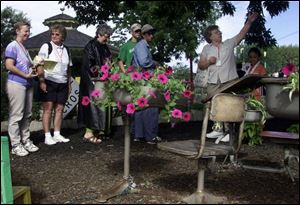
Gardens take root in Lima to cultivate young sprouts
7/13/2001
Participants in the tour, most of whom are master gardeners or 4-H leaders, view the children's garden in Allen County. Flowers planted inside a school desk, in foreground, are among the draws for young visitors.
LIMA, Ohio - It took an extension agent who had been working in Chicago to awaken Allen County officials to the fact that the county didn't have a public garden.
Five years later, a series of interconnecting gardens in the city's downtown was the first stop yesterday on a two-day tour of gardens designed to be used and viewed by children.
Led by Amy Stone, Lucas County Consumer and Horticultural agent, 35 adults and children will see four children's gardens in Ohio and Michigan.
“There is a growing interest in children's gardening and programs in the Toledo area,” Ms. Stone said.
The stops on the tour include a neighborhood garden in Cleveland and $3.4 million-dollar facility on the campus of Michigan State University in East Lansing.
Lima's garden is an example of what can be done with a lot of interest and volunteers, Kay Studer of the Allen County extension office told the tour group, most of whom are master gardeners or 4-H leaders.
The Allen County garden is owned by county commissioners and is part of the grounds of the Allen County Museum.
Jeff Byers began the garden shortly after becoming the Allen County extension agent. From Chicago, Mr. Byers was impressed by that city's public gardens.
“He came in 1996 and got fifty kids and six volunteers and started to rake,” Ms. Studer said. Ms. Studer took over the public garden project when Mr. Byers left the next year.
Museum Director Pat Smith thinks the location promotes use of the museum and the garden.
“It has incorporated lots of historic themes. It invites school children to research their own state and local history,” she told the tour.
Those historic references are a big part of the garden.
Students from the landscape program at the Apollo Joint Vocational School built a 16-foot high oil derrick that reflects Allen County's past as an oil producing region. A topiary locomotive is a green reminder that Lima once produced steam engines.
But plants and flowers are still the main draw for the group that wandered about.
Bob and Lori Ruffell from Findlay are on the tour looking for ideas that expose children to the production of food and flowers.
“If kids grow up in the city, they miss out on country things,” Bob Ruffell said.
Ms. Stone agreed.
“The mayor of Cleveland wants every school there to have a garden. I think they have gardens at 36 schools now.”
Working in a garden can deliver a number of skills, according to Ms. Stone. Planting and harvesting a cycle of vegetables teach science lessons. Measuring garden beds, lining up rows, and dropping in seeds at regular intervals hone math skills.
“And they're introduced to research skills and most importantly learn about working together,” Ms. Stone said.
Her own young son was among the children on the trip. Their time on the bus will be spent watching garden-related movies including A Bug's Life, Secret Garden, and Peter Rabbit.
Allen County's garden is about 75 percent complete, Ms. Studer said.
Adults earning their master gardener certification have contributed thousands of hours to establishing the garden, which was based on a plan drawn up in 1996 by nine landscape architecture students from Ohio State University.
A large gazebo in the center of the garden was donated by a local master gardener and is a place for lessons or a spot for lunch for the passers-by who regularly drop in.
Students at the Apollo Joint Vocational School's landscape program donated work. Volunteers in the county's youthful offender program were part of the garden's creation.
Director Connie Lowery told the tour group she thinks those volunteers took away more than they put in.
“They really saw the basics of life: the planting of seeds, watching them grow, and harvesting,'' she said.
That's the lesson those on the tour bus are hoping will take seed back in their home communities.